 W
WEgrets are herons which have white or buff plumage, and develop fine plumes during the breeding season. Egrets are not a biologically distinct group from the herons and have the same build.
 W
WThe herons are long-legged freshwater and coastal birds in the family Ardeidae, with 64 recognised species, some of which are referred to as egrets or bitterns rather than herons. Members of the genera Botaurus and Ixobrychus are referred to as bitterns, and, together with the zigzag heron, or zigzag bittern, in the monotypic genus Zebrilus, form a monophyletic group within the Ardeidae. Egrets are not a biologically distinct group from the herons, and tend to be named differently because they are mainly white or have decorative plumes in breeding plumage. Herons, by evolutionary adaptation, have long beaks.
 W
WNyctanassa is a genus of night herons from the Americas, especially warmer coastal regions. They were formerly included in the genus Nycticorax, but today all major authorities recognize them as different.
 W
WArdea is a genus of herons. The genus name comes from Latin ardea "heron". Linnaeus named this genus as the great herons, referring to the generally large size of these birds, typically 80–100 cm or more in length.
 W
WThe Bennu heron is an extinct, very large heron from the area that now is the United Arab Emirates. Remains of the heron have been dated to 2700–1800 BCE, coinciding with the Umm al-Nar period.
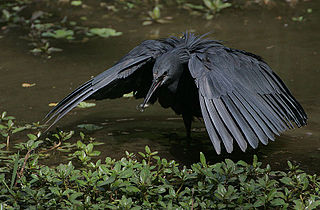 W
WThe black heron also known as the black egret, is an African heron. It is well known for its habit of using its wings to form a canopy when fishing.
 W
WThe black-crowned night heron, or black-capped night heron, commonly shortened to just night heron in Eurasia, is a medium-sized heron found throughout a large part of the world, except in the coldest regions and Australasia.
 W
WButorides is a genus of small herons. It contains three similar species, the green heron or green-backed heron, Butorides virescens, the lava heron, and the striated heron, Butorides striatus. A fossil species, Butorides validipes, is known from the Early Pleistocene of Florida in the United States. Butorides is from Middle English Butor "bittern" and Ancient Greek -oides, "resembling".
 W
WThe capped heron is a water bird endemic to the neotropics, inhabiting the Amazonian rainforest from the center of Panama to the south of Brazil. It is the only species of the genus Pilherodius, and one of the least known of the heron family, Ardeidae. It is superficially similar to the group of the night herons, but is active during daytime or at twilight.
 W
WThe Chinese pond heron is an East Asian freshwater bird of the heron family, (Ardeidae).
 W
WThe cocoi heron is a species of long-legged wading bird in the heron family Ardeidae found across South America. It has predominantly pale grey plumage with a darker grey crest. A carnivore, it hunts fish and crustaceans in shallow water.
 W
WThe eastern great egret, a white heron in the genus Ardea, is usually considered a subspecies of the great egret. In New Zealand it is known as the white heron or by its Māori name kōtuku. The subspecies was first described by British ornithologist John Edward Gray in 1831.
 W
WThe Goliath heron, also known as the giant heron, is a very large wading bird of the heron family, Ardeidae. It is found in sub-Saharan Africa, with smaller numbers in Southwest and South Asia.
 W
WThe great blue heron is a large wading bird in the heron family Ardeidae, common near the shores of open water and in wetlands over most of North America and Central America, as well as the Caribbean and the Galápagos Islands. It is a rare vagrant to coastal Spain, the Azores, and areas of far southern Europe. An all-white population found in south Florida and the Florida Keys is known as the great white heron. Debate exists about whether this represents a white color morph of the great blue heron, a subspecies of it, or an entirely separate species. The status of white individuals known to occur elsewhere in the Caribbean, and very rarely elsewhere in eastern North America, is unclear.
 W
WThe great egret (Ardea alba), also known as the common egret, large egret, or great white egret or great white heron is a large, widely distributed egret, with four subspecies found in Asia, Africa, the Americas, and southern Europe. Distributed across most of the tropical and warmer temperate regions of the world, it builds tree nests in colonies close to water.
 W
WThe green heron is a small heron of North and Central America. Butorides is from Middle English butor "bittern" and Ancient Greek -oides, "resembling", and virescens is Latin for "greenish".
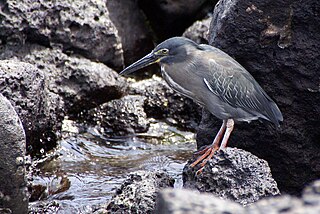 W
W"Green-backed heron" is a collective term for certain herons. Small and compact among herons, these birds often feature green plumage – rare among the Ardeidae –, in particular on the back, wings and scapulars.
 W
WThe grey heron is a long-legged predatory wading bird of the heron family, Ardeidae, native throughout temperate Europe and Asia and also parts of Africa. It is resident in much of its range, but some populations from the more northern parts migrate southwards in autumn. A bird of wetland areas, it can be seen around lakes, rivers, ponds, marshes and on the sea coast. It feeds mostly on aquatic creatures which it catches after standing stationary beside or in the water or stalking its prey through the shallows.
 W
WThe black-headed heron is a wading bird of the heron family Ardeidae, common throughout much of sub-Saharan Africa and Madagascar. It is mainly resident, but some west African birds move further north in the rainy season.
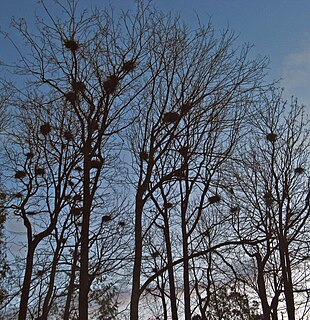 W
WA heronry, sometimes called a heron rookery, is a breeding ground for herons.
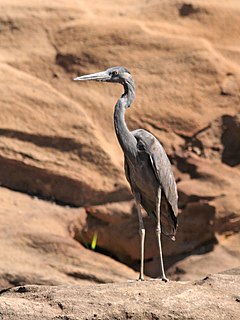 W
WHumblot's heron, also known as the Madagascar heron, is a species of heron. In Madagascar, it is common on the north and west coasts of the island, but is also found inland, especially near Lake Alaotra. It is also present in the Comoro Islands and Mayotte. Humblot's heron is an endangered species, with a population estimated at only 1,500 mature individuals. Its population is apparently declining. The major threats the heron faces are poaching and habitat destruction
 W
WThe Indian pond heron or paddybird is a small heron. It is of Old World origins, breeding in southern Iran and east to the Indian subcontinent, Burma, and Sri Lanka. They are widespread and common but can be easily missed when they stalk prey at the edge of small water-bodies or even when they roost close to human habitations. They are however distinctive when they take off with bright white wings flashing in contrast to the cryptic streaked olive and brown colours of the body. Their camouflage is so excellent that they can be approached closely before they take to flight, a behaviour which has resulted in folk names and beliefs that the birds are short-sighted or blind.
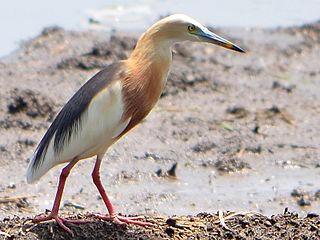 W
WThe Javan pond heron is a wading bird of the heron family, found in shallow fresh and salt-water wetlands in Southeast Asia. Its diet comprises insects, fish, and crabs.
 W
WThe Malagasy pond heron is a species of heron of the family Ardeidae. They are primarily seen in the outer islands of the Seychelles, Madagascar, and on the east coast of Africa including Kenya, Tanzania, and Uganda. Being native to Madagascar, this species is often referred to as the Madagascar pond heron or Madagascar squacco heron. The population of this heron is estimated at 2,000–6,000 individuals, with only 1,300–4,000 being mature enough to mate.
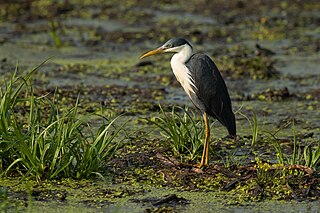 W
WThe pied heron, also known as the pied egret is a bird found in coastal and subcoastal areas of monsoonal northern Australia as well as some parts of Wallacea and New Guinea.
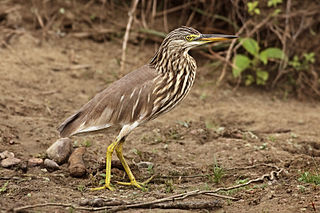 W
WPond herons (Ardeola) are herons, typically 40–50 cm (16–20 in) long with an 80–100 cm (31–39 in) wingspan. Most breed in the tropical Old World, but the migratory squacco heron occurs in southern Europe and the Middle East and winters in Africa. The scientific name comes from Latin ardeola, a small heron (ardea).
 W
WThe purple heron is a wide-ranging species of wading bird in the heron family, Ardeidae. The scientific name comes from Latin ardea "heron", and purpureus, "coloured purple". It breeds in Africa, central and southern Europe, and southern and eastern Asia. The Western Palearctic populations migrate between breeding and wintering habitats whereas the African and tropical-Asian populations are primarily sedentary, except for occasional dispersive movements.
 W
WThe squacco heron is a small heron, 44–47 cm (17–19 in) long, of which the body is 20–23 cm (7.9–9.1 in), with 80–92 cm (31–36 in) wingspan. It is of Old World origins, breeding in southern Europe and the Greater Middle East.
 W
WThe striated heron also known as mangrove heron, little heron or green-backed heron, is a small heron, about 44 cm tall. Striated herons are mostly non-migratory and noted for some interesting behavioral traits. Their breeding habitat is small wetlands in the Old World tropics from west Africa to Japan and Australia, and in South America and the Caribbean. Vagrants have been recorded on Oceanic islands, such as Chuuk and Yap in the Federated States of Micronesia, the Marianas and Palau; the bird recorded on Yap on February 25, 1991, was from a continental Asian rather than from a Melanesian population, while the origin of the bird seen on Palau on May 3, 2005 was not clear.
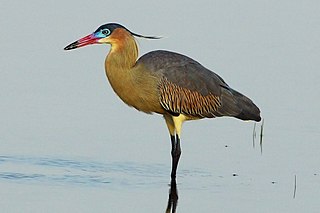 W
WThe whistling heron is a medium-sized, often terrestrial heron of South America. There are two subspecies, the southern S. s. sibilatrix and the northern S. s. fostersmithi.
 W
WThe white-necked heron or Pacific heron is a species of heron that is found on most of the Australian continent wherever freshwater habitats exist. It is also found in parts of Indonesia, New Guinea and New Zealand, but is uncommon in Tasmania. The populations of this species in Australia are known to be nomadic like most water birds in Australia, moving from one water source to another often entering habitats they have not previously occupied, taking advantage of flooding and heavy rain where the surplus of food allows them to breed and raise their young. Population explosions have been known when the environmental conditions are right for this species in places where they have been rare or unknown.
 W
WThe zigzag heron is a species of heron in the family Ardeidae, also including egrets and bitterns. It is in the monotypic genus Zebrilus. It is found in Bolivia, Brazil, Colombia, Ecuador, French Guiana, Guyana, Peru, Suriname, and Venezuela. Its natural habitat is subtropical or tropical swamps.